When we visited Seoul last month, Gyeongbokgung Palace was one of our top places to visit. We've seen the palace countless times in various sageuk or Korean historical dramas and we wanted to have the opportunity to walk through its walls and experience moments to revel in its historical legacy.
Eager and full of energy, we set off early that day for our first stop - Hanbok Girls, one of the many hanbok rental shops within the neighborhoods near the royal palaces. After all, wearing these traditional clothes gives visitors free access to any of the five grand palaces of Seoul. We also wanted to experience what would it have been like visiting the palace during the ancient Joseon Dynasty.
Gyeongbokgung Palace which means "Greatly Blessed by Heaven" was constructed in 1395, during the early days of the Joseon Dynasty. As it was the main palace of the capital city, Gyeongbokgung was extraordinary in size. It spans an area of 41 hectares with 5,792 rooms and surrounded by walls reaching 2,404 meters in length. At its height, the palace was a self-functioning unit comparable to China's Forbidden City.
After donning our beautiful and surprisingly comfortable hanboks, we made our way inside the palace to begin our exploration.
We came in from the main entrance to the south called Gwanghamun Gate. Though, rebuilt many times over the centuries, Gwanghamun remains an icon and a central landmark of Seoul. It has a double-roofed pavilion over three arched openings with the center entrance reserved only for the king. This center entrance is closed so visitors can only pass through the openings on either side. There are sculptures of two Hae T'ae or sea monsters at the sides which was said to protect the palace from fires. We were also lucky enough to see the royal changing of the guards ceremony performed at the gate.
We then passed through the inner Heungnyemun Gate. This is a two-story wooden structure which was beautifully restored. Few steps from the gate is the Yeongjegyo Bridge with two stone arches. The stream that runs underneath Yeongjegyo is Geumcheon Stream. All royal palaces has this similar feature which symbolizes purifying oneself before entering. We spent some time here to have some photo opportunities before proceeding through the innermost gate, Geunjeongmun Gate.
As we got past the third gate, we were greeted by the largest and most imposing hall in the complex, the Geunjeongjeon Hall. Geunjeongjeon Hall was the palace's political heart and where the government's most important functions were carried out. Joseon kings held official state ceremonies and received foreign visitors and envoys in this hall.
In front of the hall extends a grand courtyard. Its central walkway is lined with two rows of rank stones known as pumgyeseoks. These stones mark where court officials will stand according to their ranks during ceremonies and audiences. The entire courtyard is enclosed by a rectangular tiled-roof corridor.
Geunjeongjeon is built mostly of wood that sits on top of a two-tiered stone platform. We went up the elevated platform and observed that it is surrounded by detailed balustrades and is decorated by sculptures depicting both real and imaginary creatures like dragons and phoenixes.
After taking lots of Instagram-worthy photos from the terraced foundation, we hustled with the crowd to see the hall. Its pillars, walls, and eaves are ornately decorated with dancheong, the beautiful five-colored designs on traditional Korean wooden buildings. These vibrant colors were not purely decorative as they preserve the wood from rotting caused by wind, rain, and pests. They were also believed to protect the hall from evil spirits and emphasize the authority of the king. Of course the centerpiece of Geunjeongjeon is the throne. It is located at the rear center of the hall. The king's throne sits in front of a folding screen called Ilwoloakdo. The beautiful folding screen is embroidered with the red sun representing the king, the white moon representing the queen, the five mountain peaks representing fair and correct administration, and the water and pine trees representing life.
Right behind Geunjeongjeon are other Outer Court buildings called Sajeongjeon and the two auxiliary buildings Manchunjeon Hall and Cheonchujeon Hall. These served as the reception halls where the king met with his officials and presided over meetings.
Next, we passed by Sujeongjeon Hall to the west, which looks like one of the many regular buildings in the palace complex. It was a surprise to find out that the hall was very significant in Korean history. This was the location where the Korean writing system and many other scholarly achievements were developed. The hall often gets overlooked because it is situated right next to the stunningly beautiful Gyeonghoeru Pavilion.
The Gyeonghoeru Pavilion treats visitors with some of the most beautiful views within Gyeongbokgung Palace. It is an elevated pavilion within a large man made pond. Its architectural design is said to symbolize heaven, earth, man, and time. It is a great place to take in the beauty of the palace grounds and Mt. Inwangsan in all four seasons of the year. No wonder, the hall served as a venue of banquets and a playground for the royal family. We took lots of photos here.
We then explored the once exclusive area of Gyeongbokgung, the Inner Court. This area served as the residential quarters for the king and the royal family. The Gangnyeongjeon Hall was the king's living quarters and resting space. This was built in a checkedboard pattern of fourteen rectangular chambers and corridors with the central chamber used by the king.
Gangnyeongjeon is connected to Gyotaejon Hall by Yanguimun Gate. This was where the queen resided and where she oversaw operations of the household at the palace. At its rear lies the garden of Amisan. This famous and beautiful garden features a terraced flower garden, decorated stonework, and four chimneys.
Located further north is another of the complex's scenic and iconic gems - Hyangwonjeong, a unique two-story hexagonal pavilion built on a small island in the middle of a pond. It can be reached via a wooden bridge. Unfortunately, during our visit, Hyangwonjeong had been walled off for restoration. We just settled ourselves into seeing the pavilion from the glass portions of the wall.
Continuing to the end of Gyeongbokgung, we reached Geoncheonggung. This was a palace built by King Gojong to assert his political independence from his father which probably explains its difference in terms of style and color to the rest of the buildings in the palace complex. Geoncheonggung was built in a yangban or noble household style with its own living quarters. This was also the scene where Queen Myeongseong was murdered by Japanese assassins.
After touring Geoncheonggung, we turned around to head back towards the main entrance, again passing by the magnificent halls, gates, and courtyards on the way through. By this time, we have been walking around Gyeongbokgung for four hours. We were not feeling completely palaced out yet but we were famished from all the exploring. So we headed to Bukchon to look for a good place to eat.
We never made it to the National Palace Museum and National Folk Museum which are both within the grounds of Gyeongbokgung. We hope to come back to see more of these sites.
For more information about the palace, visit the official website here.
Have you visited Gyeongbokgung Palace? Do you have any extra tips for visiting this storied sight? Please share them in the comment box below.
Read our other Seoul-related posts:
Seoul: A Budget Travel Guide for Juans
Seoul: A Travel Guide for First Timers
How to Apply for a South Korea Tourist Visa for Filipinos
Yangban For A Day: Suiting Up A Hanbok
Seeing from Above the N Seoul Tower
Beyond Seoul: Exploring Nami Island
Beyond Seoul: Visiting the Garden of Morning Calm
Beyond Seoul: Being Inspired at Petite France
How to Get to Nami Island, Petite France, and the Garden of Morning Calm
Waking Up to Good Things at Yellow Brick Hostel Seoul
How to Claim Shopping Tax Refund in South Korea
 |
| Gyeongbokgung Palace, arguably Seoul's grandest and most beautiful palace |
Gyeongbokgung Palace which means "Greatly Blessed by Heaven" was constructed in 1395, during the early days of the Joseon Dynasty. As it was the main palace of the capital city, Gyeongbokgung was extraordinary in size. It spans an area of 41 hectares with 5,792 rooms and surrounded by walls reaching 2,404 meters in length. At its height, the palace was a self-functioning unit comparable to China's Forbidden City.
After donning our beautiful and surprisingly comfortable hanboks, we made our way inside the palace to begin our exploration.
We came in from the main entrance to the south called Gwanghamun Gate. Though, rebuilt many times over the centuries, Gwanghamun remains an icon and a central landmark of Seoul. It has a double-roofed pavilion over three arched openings with the center entrance reserved only for the king. This center entrance is closed so visitors can only pass through the openings on either side. There are sculptures of two Hae T'ae or sea monsters at the sides which was said to protect the palace from fires. We were also lucky enough to see the royal changing of the guards ceremony performed at the gate.
 |
| The imposing Gwanghamun Gate |
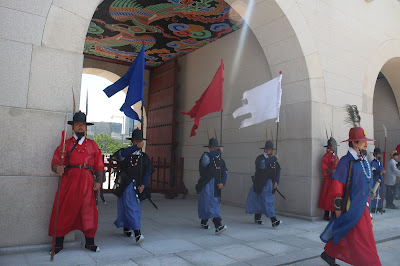 |
| The royal changing of the guards ceremony is performed daily at 10:00AM and 2:00PM |
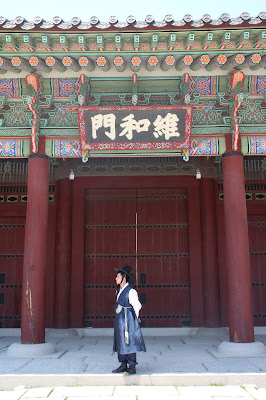 |
| Photo ops at Heungnyemun Gate |
In front of the hall extends a grand courtyard. Its central walkway is lined with two rows of rank stones known as pumgyeseoks. These stones mark where court officials will stand according to their ranks during ceremonies and audiences. The entire courtyard is enclosed by a rectangular tiled-roof corridor.
 |
| The expansive courtyard around Geunjeongjeon |
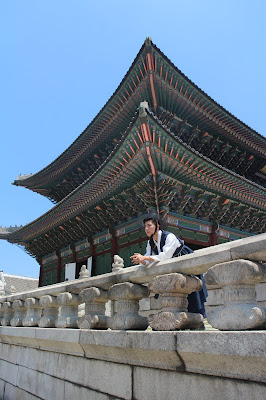 |
| Detailed balustrades and ornately decorated pillars, walls, and eaves with dancheong seen up close |
 |
| The royal throne of Gyeongbokgung Palace |
Next, we passed by Sujeongjeon Hall to the west, which looks like one of the many regular buildings in the palace complex. It was a surprise to find out that the hall was very significant in Korean history. This was the location where the Korean writing system and many other scholarly achievements were developed. The hall often gets overlooked because it is situated right next to the stunningly beautiful Gyeonghoeru Pavilion.
 |
| The historic and important Sujeongjeon Hall |
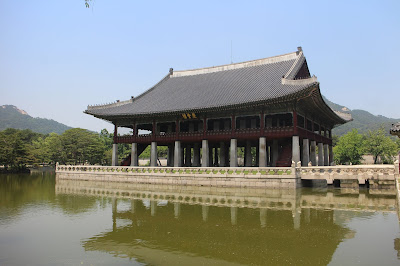 |
| The stunning Gyeonghoeru Pavilion |
 |
| Gangnyeongjeon Hall where the King of Joseon resided |
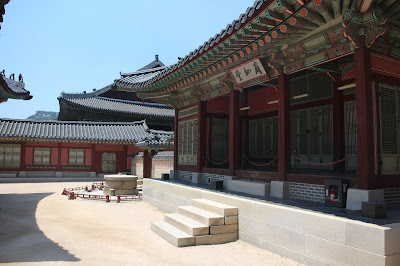 |
| The adjacent chambers to Gangnyeongjeon where court attendants to the king live |
 |
| Gyotaejon Hall where the Queen of Joseon resides |
 |
| The inner chambers of Gyotaejon with a glimpse of Amisan garden at the back |
 |
| Open grounds and greeneries are common sights in Gyeongbokgung |
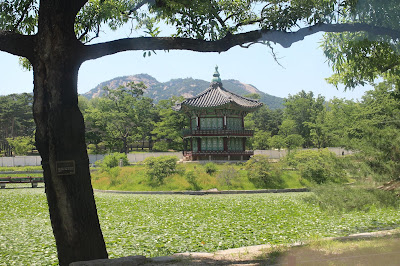 |
| The beautiful and iconic Hyangwonjeong Pavilion |
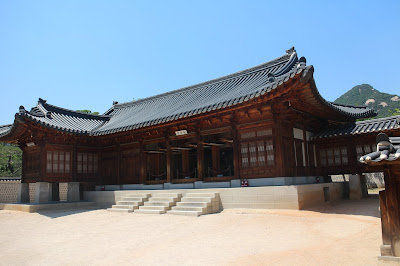 |
| Geoncheonggung Palace looking like a yangban household |
We never made it to the National Palace Museum and National Folk Museum which are both within the grounds of Gyeongbokgung. We hope to come back to see more of these sites.
For more information about the palace, visit the official website here.
 |
| Map of Gyeongbokgung |
Read our other Seoul-related posts:
Seoul: A Budget Travel Guide for Juans
Seoul: A Travel Guide for First Timers
How to Apply for a South Korea Tourist Visa for Filipinos
Yangban For A Day: Suiting Up A Hanbok
Seeing from Above the N Seoul Tower
Beyond Seoul: Exploring Nami Island
Beyond Seoul: Visiting the Garden of Morning Calm
Beyond Seoul: Being Inspired at Petite France
How to Get to Nami Island, Petite France, and the Garden of Morning Calm
Waking Up to Good Things at Yellow Brick Hostel Seoul
How to Claim Shopping Tax Refund in South Korea

No comments:
Post a Comment